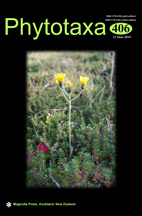Abstract
A new species of Neoroussoella (Roussoellaceae) collected in Taiwan is introduced from Pennisetum purpureum with both asexual and sexual morphs. Phylogenetic analysis of a concatenated LSU-ITS-SSU-TEF1-α-RPB2 sequence dataset reveals that the new species forms a distinct sister clade with N. bambusae with high statistical support (100% ML/ 1.00 BYPP). Neoroussoella alishanense is morphologically similar with the generic type, N. bambusae, but N. alishanense is distinct in having larger ascomata and its ascospores lack a mucilaginous sheath. While, N. bambusae has smaller ascomata and its ascospores are surrounded by a mucilaginous sheath. A comparison of ITS, RPB2 and TEF1-α nucleotide bases shows that they are distinct species.

